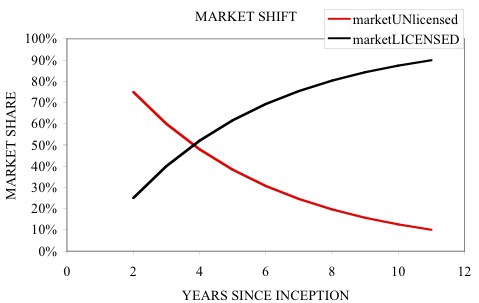Industry
strategic implications of user expectations and choice
All industries are driven by customer needs, wants,
and expectations. Customers rarely get the "perfect" product, and
in fact rarely expect it, even though this fact is equally rarely
noticed.
Dissatisfaction is a powerful driver of choice by
customers. Customers rarely become dissatisfied with their purchase
unless they see
a better
one was
possible.
Product
variation
is
necessary for customers to experience dissatisfaction.
Thus, all purchasing choice
is driven by product variation: without variation
there's no scope for dissatisfaction or choice. But once product
variation and differentiation
appear, choice follows.
The present widely recognised problem of hard-to-open
bags resonates with virtually every user. This applies to the
market for simple side-gusseted and side-welded (un-gusseted) bags.
The 'hard-to-open' problem now constitutes an industry
instability. Why? ... because a near-zero-cost solution has
finally been found, but only Licensees can use.
This
solution 'raises the bar' of performance and will affect customer
expectations.
Users have hitherto been tolerant and forgiving because
the problem has been perceived as 'the nature of the beast', i.e.
unavoidable. Once users witness the solution, however,
expectations of performance will rise, and users will increase
complaints and product returns, and will migrate toward Licensees.
BETTER USEABILITY --> PRODUCT PREFERENCE --> PURCHASE
PREFERENCE
Market
dynamics and Industry consolidation
Your
choice as a manufacturer is simple: do you want this
before your competitor gets it?
What's market worth?
What's control worth? |
The flip side of 'industry instability' is business
opportunity. The new Licensable IP can be a powerful business
tool for Licensees. This solution will differentiate a class of
products,
competing in all the traditional applications of side-gusseted
or side-welded bags.
After
all those years of "bags that fight back", customers will witness
the improvement with relief. Their performance
expectations
will be raised, they will demand and seek the product that
relieves them of the traditional headache. That will cause a rapid
shift
of market toward our Licensees; in some market segments our
target for this shift is 80%.
How could that play out? Suppose for example that
in the first two years SFT Licenses under 25% of the current production/supply
companies, or the equivalent in present market. Suppose only 20%
of the remaining market's customers move to Licensees each year:
within 10 years virtually the entire market will be concentrated
in Licensees.

If the market switch is completely absorbed by the
initial set of Licensees, that 10 years would see their own market
multiplied by a factor of 3.6. The model is simple; if however
we acknowledge that the customer migration rate would increase,
then the market consolidation could occur more quickly.
The main driver of the industry shift is the benefits
perceived by the user. Similar preference at the retail level will
influence consumer choice of branded products. SFT's branding strategy
is to allow Licensee brands to dominate on product or packaging
while benefiting from the presence of SFT's brand as a symbol of
quality.
After a small number of years it is likely that much
of the market will have migrated away from non-Licensees. With
markets favouring Licensees, non-Licensees would either move to
other segments of the business or close. The industry will stabilise
around the groups of companies able to meet the higher expectations
of customers.
Licenses will allow Licensees to make, commission,
use, and sell. Though not shown in the table, the retail consumer
or the employee actually using bags is the driver for the market
shift. Consumers drive retailers to stock the Licensed product.
Employees using bags drive employers to supply bags that don't
waste their time
|
MANUFACTURER
|
SUPPLIER/
DISTRIBUTOR
|
MAJOR
USER
|
END
USER (CONSUMER or EMPLOYEE)
|
license allows
|
make & sell
|
commission & sell
|
commission and use
|
n/a
|
practical advantage
|
fewer product returns;
more customers
|
fewer product returns;
more customers
|
saved time/wages
reduced bag waste
improved workflow
better hygiene
|
less frustration
easier work
fewer wasted bags
saved time
no spitting needed
|
strategic advantage
|
defend market, gain market
(in response to customer demand)
|
defend market, gain market
(in response to customer demand)
|
increased competitiveness
|
improved satisfaction with
work/task
|
How
to beat offshore
cut-rate producers? ... control the market
Offshore
cut-rate producers have taken a large market share and even with
countervailing duties (sometimes dodged by shifiting the site
of manufacture to some other country not mentioned in the regulation)
can be difficult to compete against. As one producer told us
"I can't even buy the resin for what they charge for finished
bags".
So,
here is an opportunity: tilt the playing field in your favour.
With
a License from SFT, market SFT's better bags; order the bags
(to the SFT-enabled specification) from your offshore competition,
who can't sell the same specification to your market without
a
License.
SFT's
strategy
Clearly, the consumer will demand
the improved bags. To facilitate that, our Licensing strategy is
aimed at having the improved product priced at no perceptible cost
increase.
Our
strategy is to License only a portion of the current market capacity,
and
let that absorb market from non-Licensees.
What's
it worth to not let your competitors get this first?
Contact us to discuss
how you can be on board early to gain the greatest
advantages.